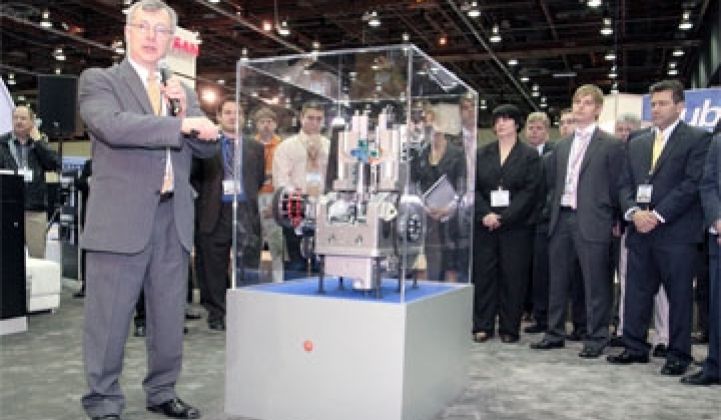Gas isn't the fuel for car engines. Air is.
That, in part, is the theory behind Scuderi Split-Cycle Engine, a startup that has devised a novel gas engine that increases overall efficiency by 10 percent to 50 percent and cuts down on NOx gases at the same time by changing the way air gets channeled through an engine.
Scuderi completed a four-cylinder prototype last year and in about a month will come out with comprehensive test data on how it performs. A few months after that, the company hopes to show data pertaining to how well the engine did in a retrofitted Chevy Cavalier. The car test, ideally, will also let the company demonstrate how well the improvement in efficiency translates into better gas mileage.
So far, the company has raised about $45 million and is trying to raise another $40 million, according to Bill Wrinn, director of marketing for the company.
While electric cars grab all of the headlines, efficient combustion engines may actually well play a larger role in reducing gas consumption over the next several decades. Ford has placed a big bet on its EcoBoost engine, a gas engine with some diesel-like properties that can improve mileage by 10 percent to 15 percent. General Motors, meanwhile, wants to expand the infrastructure for ethanol and E85 cars. At Volkswagen, diesel gets more enthusiasm than electrics.
Startups like EcoMotors, Transonic Combustion and Achates Power have, like Scuderi, devised more energy efficient engines and components they want to sell or license. Another Silicon Valley startup (I'm sworn to secrecy on this one) will soon come out with a novel engine for generators. Some VCs, notably Maurice Gunderson of CMEA, argue that combustion engine improvements are more realistic than electric cars.
These startups have all engaged in discussions with major car makers -- particularly Asian car makers -- but getting to market will be a tough, uphill climb. Like with semiconductor manufacturers, licensing ranks right up with terms like "audit," "colonoscopy" and "dinner theater": best avoided whenever possible. Testing and certification can also take years in cars, far longer than the testing cycle for semis.
On the other hand, various national governments have imposed new emissions standards in recent years, which may force car makers to accelerate their product roadmaps and, in a pinch, to reach out to startups. EcoMotors is already in discussions with an Asian manufacturer.
Scuderi's split-cycle engine is a "naturally aspirated gas engine" that breathes better than normal engines, according to Wrinn. In conventional engines, pistons rise and compress air in a cylinder. Gas, heat and a spark are added to the same piston, resulting in combustion.
In Scuderi's engine, the pistons on the left side of the engine compress air. The air then travels through a passage connected to the cylinders on the right side of the engine, where the gas is introduced (hence the term 'split-cycle'). The passageway architecture leads to a significantly higher air pressure, which in turn leads directly to more fuel being burned and more energy being turned into productive work.
Inventors have tinkered with split-cycle engines since 1914. They haven't worked well because the energy in the compressed air gets dissipated before it can be used effectively. Scuderi gets around this with a set of valves and other technology that push nearly 100 percent of the compressed air into the combustion cylinder. Meanwhile, the pistons on the combustion side are synchronized with how the air will get released from the passageway. In an ordinary piston cycle, the air would expand and then have to be recompressed. More technical details can be found here.
The lower-than-average NOx emissions come because the higher pressures allow the engine to operate at lower peak temperatures. The average temperature is higher, but the peak is lower. Because it doesn't hit the same peak, the chemical reaction to create NOx doesn't spread, according to Wrinn. NOx emissions are reduced by 80 percent.
Added bonus: the engine also recaptures some of the post-compression air pressure and feeds it back into the compression cylinder to pre-compress the incoming air. This air-hybrid effect allows the engine to achieve a 50 percent improvement in efficiency, he said.
Ultimately, the company will license the design to car makers. It also hopes to come out with a diesel version: the ability to reduce NOx naturally would likely be appealing to diesel makers who now have to insert additional components or materials to tackle that job.
Carmelo Scuderi, an engineer that worked on various defense projects for Raytheon and others during his life, came up with the design. Among other projects, he played a crucial role in developing test systems for space suits for NASA and a compressor that hindered the release of CFCs. Discovery hailed the compressor as one of the technologies that has been important in repairing the ozone layer.
He finalized the Scuderi engine design in 2001, but died in 2002. His kids are behind the current commercial push. (Side note: family affairs are big in cleantech. Rivertop Renewables, Silver Spring Networks, and Hycrete are all father-son or grandfather-son companies.)



